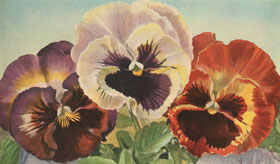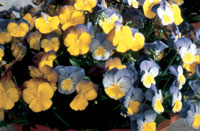11/26/2012
Growing Perfect Pansies
Mark Seguin
 In recognition of All-America Selections 80th anniversary, GrowerTalks is featuring a series of Culture Notes articles on previous AAS winners during 2012.
In recognition of All-America Selections 80th anniversary, GrowerTalks is featuring a series of Culture Notes articles on previous AAS winners during 2012.
Pansies are one of the most popular annuals for early fall to late spring color. In recent years, breeding programs have brought unique flower colors; medium, large and extra-large flower sizes; increased flower power and wider temperature tolerance. Today’s modern pansies originated from two perennials, Viola tricolor and Viola lutea, native to the Swiss Alps. These violas regenerated in autumn and flowered the following spring under increasing day length. Today’s gardeners are fortunate that breeders have developed more free-flowering varieties, like Majestic Giants ll, that don’t require vernalization or a certain critical photoperiod to flower.
In the Southern U.S. and other mild winter climates, like California, pansies are generally planted beginning in early fall and provide months of color and enjoyment. Although fall-planted pansies are an option in colder northern climates, spring is the most popular time to plant them. Offering pansies in color bowls or in mixed planters with dianthus and primula is very popular for gardeners with shorter growing seasons or those living in apartments. Planters also offer more flexibility, allowing gardeners to enjoy them up close rather than in the landscape.
Dw arf Swiss Giants from Vaughn’s Seeds (above) was the first pansy variety that won an AAS award in 1933. Ultima Morpho (left) from Sakata Ornamentals was the last winner in 2002.
arf Swiss Giants from Vaughn’s Seeds (above) was the first pansy variety that won an AAS award in 1933. Ultima Morpho (left) from Sakata Ornamentals was the last winner in 2002.
For containers and window boxes, most consumers like the blotched types as they can easily see the pansy face up close. In the landscape, clear-faced types planted in blocks of solid color make bold statements and add much needed color to winter gardens. Pansies are easy to produce—especially with primed seed—and tolerate wide temperature ranges. Medium and large-sized pansies, such as Supreme and the new Grandio series from Sakata, do well in mass plantings in open areas and are less beaten down by heavy rains. Extra-large types, including the first-ever clear-faced Majestic Giant ll Clear Yellow, shine in containers and window boxes and up close around buildings where their stunning colors can be better appreciated. Pansies are truly a joy to grow and plant as they reward us with such an abundance of color when it’s most needed.
Plug Culture—30 days (288 / 12 x 24 tray)
Stage One (Days 1 to 6) Sow pansy seed in a 288-plug cell using a well-aerated, long fiber peat plug mix with a pH between 5.5 and 5.8. Cover lightly with either medium or coarse vermiculite. After sowing, water the plug flats well and maintain a soil temperature between 64 to 68F (18 to 20C). The use of primed seed and a germination chamber with a fine mist system to maintain 100% relative humidity is ideal.
Stage Two (Days 7 to 14) If using a germination chamber, be sure to remove pansy plug flats when the seed coat is cracked. When green begins to appear in the flat, lightly fertilize with 75 ppm N from a well-balanced fertilizer. To avoid boron deficiency, target boron at 0.25 ppm in the fertilizer. If needed, supplement with Solubor or Borax. Maintain temperatures as cool as possible with good airflow. Supply up to 3,000 foot candles / 32,000 Lux of light. After the initial feed, begin fertilizing with 200 ppm N from a well-balanced fertilizer containing trace elements. A calcium nitrate-based fertilizer works well to build strong, compact plants.
Stage Three (Days 15 to 25) Reduce fertilizer as plants begin to fill trays. When applying fresh water (no fertilizer), still apply trace elements—especially boron—and keep water alkalinity at 60 to 80 HCO3 to maintain soil pH between 5.5 and 5.8. Fertilizer concentrations can be reduced to 150 ppm, but maintain trace elements at full strength, especially boron at 0.25 ppm. Ideally, pansy plug flats should be given higher light levels to control stretch. Moving plants outdoors under a saran house will reduce temperatures and provide optimal air movement. Maintain light levels up to 7,000 foot candles / 75,000 Lux, but avoid heat and water stress. If plant height control is needed, B-Nine (daminozide), Cycocel (chlormequat) and A-Rest (ancymidol) are effective. Begin spraying when the leaves are the size of a dime. Optimum EC is 1.0 to 1.2 mmhos (2:1 slurry).
Stage Four (Days 26 to 30) Plug flats are approaching market size. Feed every second or third watering, alternating with acid, if needed, and trace elements to maintain soil pH and trace element supply, especially boron. During periods of hot and humid weather, or before shipping plugs in a box or truck, apply either Manzate or Zyban to control anthracnose. Do not delay transplanting, which delays flowering and reduces quality.
GT
Mark Seguin is Global Ornamental Marketing Manager, Vegetative Cuttings for Sakata Ornamentals.